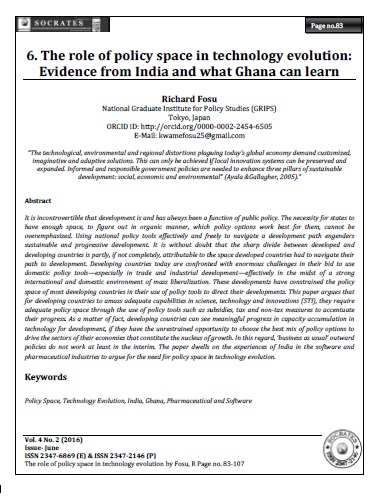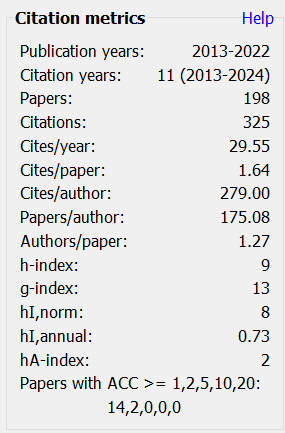The role of policy space in technology evolution
Evidence from India and what Ghana can learn
Keywords:
Policy Space, Technology Evolution, India, Ghana, Pharmaceutical and SoftwareAbstract
It is incontrovertible that development is and has always been a function of public policy. The necessity for states to have enough space, to figure out in organic manner, which policy options work best for them, cannot be overemphasized. Using national policy tools effectively and freely to navigate a development path engenders sustainable and progressive development. It is without doubt that the sharp divide between developed and developing countries is partly, if not completely, attributable to the space developed countries had to navigate their path to development. Developing countries today are confronted with enormous challenges in their bid to use domestic policy tools—especially in trade and industrial development—effectively in the midst of a strong international and domestic environment of mass liberalization. These developments have constrained the policy space of most developing countries in their use of policy tools to direct their developments. This paper argues that for developing countries to amass adequate capabilities in science, technology and innovations (STI), they require adequate policy space through the use of policy tools such as subsidies, tax and non-tax measures to accentuate their progress. As a matter of fact, developing countries can see meaningful progress in capacity accumulation in technology for development, if they have the unrestrained opportunity to choose the best mix of policy options to drive the sectors of their economies that constitute the nucleus of growth. In this regard, ‘business as usual’ outward policies do not work at least in the interim. The paper dwells on the experiences of India in the software and pharmaceutical industries to argue for the need for policy space in technology evolution.
Downloads
Metrics
References
Allred, B. B., & Park, W. G. (2007). The influence of patent protection on firm innovation investment in manufacturing industries. Journal of International Management, 13(2), 91-109.
Arora, A., Branstetter, L., Chatterjee, C., & Saggi, K. (2009). Strong medicine? Patent reform and the transformation of the Indian pharmaceutical industry. mimeo.
Athreye, S. S. (2005). The Indian software industry and its evolving service capability. Industrial and Corporate Change, 14(3), 393-418
Ayala, F. A., & Gallagher, K. (2005). Preserving policy space for sustainable development: The subsidies agreement at the WTO. International Institute for Sustainable Development=Institut international du développement durable.
Ayyangar (1959) as in Sampat, B. N. (2010). The accumulation of capabilities in Indian pharmaceuticals and software: the roles that patents did (and did not) play. Intellectual Property Rights, Development, and Catch Up: An International Comparative Study. Oxford University Press, Oxford, 361-377
Bhatnagar, S. (2006). India’s software industry. TECHNOLOGY, ADAPTATION, AND EXPORTS, 49.
Bhatnagar, S. (2006). India’s software industry. TECHNOLOGY, ADAPTATION, AND EXPORTS, 49.
Boldrin, M., & Levine, D. K. (2013). The case against patents. The journal of economic perspectives, 27(1), 3-22.
Chang, H. J. (2006). Policy space in historical perspective with special reference to trade and industrial policies. Economic and Political Weekly, 627-633
Chaudhuri 2005 as in Arora, A., Branstetter, L., Chatterjee, C., & Saggi, K. (2009). Strong medicine? Patent reform and the transformation of the Indian pharmaceutical industry. mimeo.
Collier, P. (2008). The bottom billion: Why the poorest countries are failing and what can be done about it. Oxford University Press, USA.
Denicolò, V. (2007). Do patents over-compensate innovators?. Economic Policy, 22(52), 680-729. (mixed)
Grabowski, H. (2002). Patents, innovation and access to new pharmaceuticals. Journal of International Economic Law, 5(4), 849-860.
Hall, B. H. (2014). Does patent protection help or hinder technology transfer?. Intellectual Property for Economic Development, 11-32.http://eaindustry.nic.in/handbk/chap001.pdf http://www.forbes.com/sites/mfonobongnsehe/2013/06/12/ten-startups-in-ghana-to-watch-closely/2/#6fa5a9e02451 http://www.worldvision.org/our-impact/country-profiles/ghana
Intarakumnerd, P. (2015). Seven Unproductive Habits of Thailand’s Ineffective Technology and Innovation Policies: Lessons for other Developing Countries. Institutions and Economies (formerly known as International Journal of Institutions and Economies), 7(1), 80
JHAMB, D. R. K. (2011) CONTRIBUTION OF SOFTWARE INDUSTRY IN THE GROWTH OF INDIAN ECONOMY IN THE LAST DECADE. ZENITH International Journal of Business Economics & Management Research Vol.1 Issue 3
Lall, S., & Teubal, M. (1998). “Market-Stimulating” technology policies in developing countries: a framework with examples from East Asia. World Development, 26(8), 1369-1385
Lall, S., & Teubal, M. (1998). “Market-Stimulating” technology policies in developing countries: a framework with examples from East Asia. World Development, 26(8), 1369-1385
Main Features of Industrial Policy Resolution of 1956 ( Smriti Chand) http://www.yourarticlelibrary.com/industries/main-features-of-industrial-policy-resolution-of-1956/23438/
Martin Khor, “Debate on policy space dominates UNCTAD Review, “Third World Network Information Service on WTO and Trade Issues, May 9, 2006, http://www.twnside.org.sg/title2/twninfo409.htm
Martin, S., & Scott, J. T. (2000). The nature of innovation market failure and the design of public support for private innovation. Research policy, 29(4), 437-447
Mazumdar, M. (2013). An Overview of the Indian Pharmaceutical Sector. In Performance of Pharmaceutical Companies in India (pp. 17-44). Physica-Verlag HD.
Mazzucato, M. (2015). The entrepreneurial state: Debunking public vs. private sector myths. Anthem Press
Moser, P. (2003). How do patent laws influence innovation? Evidence from nineteenth-century world fairs (No. w9909). National Bureau of Economic Research.
Moyo, D. (2009). Dead aid: Why aid is not working and how there is a better way for Africa. Macmillan.
Muchhala, B. (2007). The Policy Space Debate: Does a Globalized and Multilateral Economy Constrain Development Policies. Woodrow Wilson International Centre for Scholars. Asia Program special report No.136
Muller (2007) as Sampat, B. N. (2010). The accumulation of capabilities in Indian pharmaceuticals and software: the roles that patents did (and did not) play. Intellectual Property Rights, Development, and Catch Up: An International Comparative Study. Oxford University Press, Oxford, 361-377
Parra, A. (2014). Sequential innovation and patent policy. Available at SSRN.
Sampat, B. N. (2010). The accumulation of capabilities in Indian pharmaceuticals and software: the roles that patents did (and did not) play. Intellectual Property Rights, Development, and Catch Up: An International Comparative Study. Oxford University Press, Oxford, 361-377.
Sampat, B. N. (2010). The accumulation of capabilities in Indian pharmaceuticals and software: the roles that patents did (and did not) play. Intellectual Property Rights, Development, and Catch Up: An International Comparative Study. Oxford University Press, Oxford, 361-377TD/410, June 25, 2004, http://www.unctad.org/en/docs/ td410_en.pdf. TD/410, June 25, 2004, http://www.unctad.org/en/docs/ td410_en.pdf.
Teubal (1996) as in Lall, S., & Teubal, M. (1998). “Market-Stimulating” technology policies in developing countries: a framework with examples from East Asia. World Development, 26(8), 1369-1385
The principle fifteenth General Principle of the United Nations Commission on Trade and Development (UNCTD) Charter (UNCTD, 1964), Paragraph 8 of the São Paulo Consensus of 2004
Tödtling, F., & Trippl, M. (2005). One size fits all?: Towards a differentiated regional innovation policy approach. Research policy, 34(8), 1203-1219.
Toru Yanagihara, “Development and Dynamic Efficiency: Framework Approach vs. Ingredients Approach,” Ch.4 in Japanese Views on Economic Development: Diverse Paths to the Market, eds. Kenichi and Izumi Ohno, Routledge, 1998
United Nations Conference on Trade and Development (UNCTAD),“UNCTAD XI: Sao Paulo Consensus,”
United Nations Conference on Trade and Development (UNCTD, 1964). Proceedings of the United Nations Conference on TRADE AND DEVELOPMENT. Final Act and Report. E/CONF.46/141 Vol I http://unctad.org/en/Docs/econf46d141vol1_en.pdf
William, E. (2001). The Elusive Quest for Growth: Economists’ Adventures and Misadventures in the Tropics. MIT Press
Woolcock, S. (2008). Government procurement provisions in CARIFORUM EPA and lessons for other ACP states. London: London School of Economics and Politics/Commonwealth Secretariat

Downloads
Published
How to Cite
Issue
Section
License
Revised Copyright/CC license that applies to all the articles published after 05-02-2017
Attribution-NonCommercial 4.0 International (CC BY-NC 4.0)

Copyright/CC license that applies to all the articles published before 05-02-2017
Attribution-Non Commercial-No Derivatives 4.0 International (CC BY-NC-ND 4.0)

Author(s) will retain all the right except commercial and re-publishing rights. In the case of re-publishing, they will have to obtain written permission from the journal. Additional licensing agreements (Creative Commons licenses) grants rights to readers to copy, distribute, display and perform the work as long as you give the original author(s) credit, they can not use the works for commercial purposes and are not allowed to alter, transform, or build upon the work. For any reuse or distribution, readers and users must make clear to others the license terms of this work. Any of these conditions can be waived if you get permission from the copyright holders. Nothing in this license impairs or restricts the authors’ rights. To view a copy of this license, visit http://creativecommons.org/licenses/by-nc-nd/4.0/ or send a letter to Creative Commons, 171 Second Street, Suite 300, San Francisco, California, 94105, USA.
Research Papers published in SOCRATES are licensed under an Attribution-NonCommercial-NoDerivatives 4.0 International (CC BY-NC-ND 4.0)












